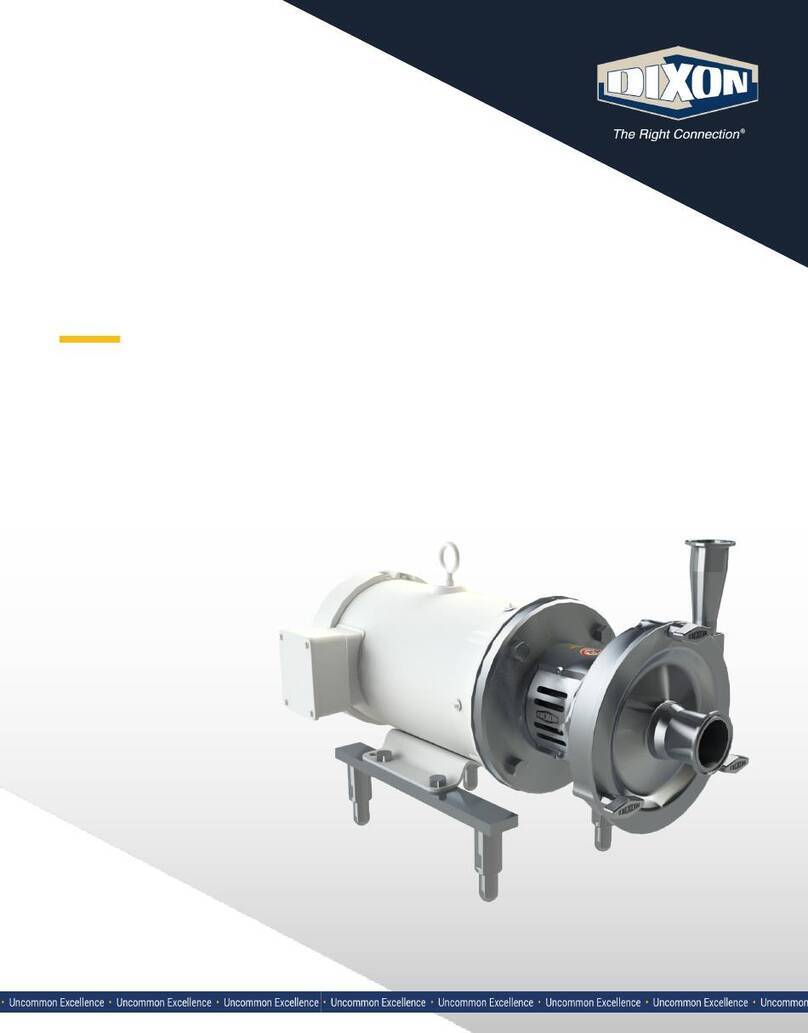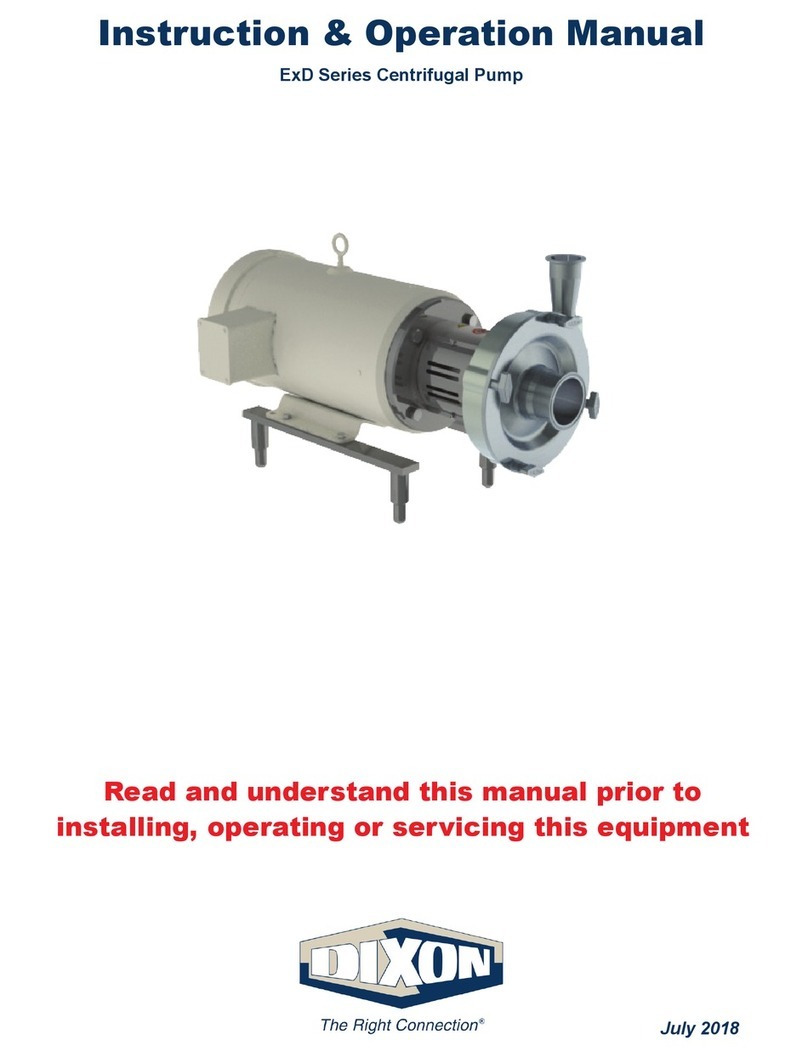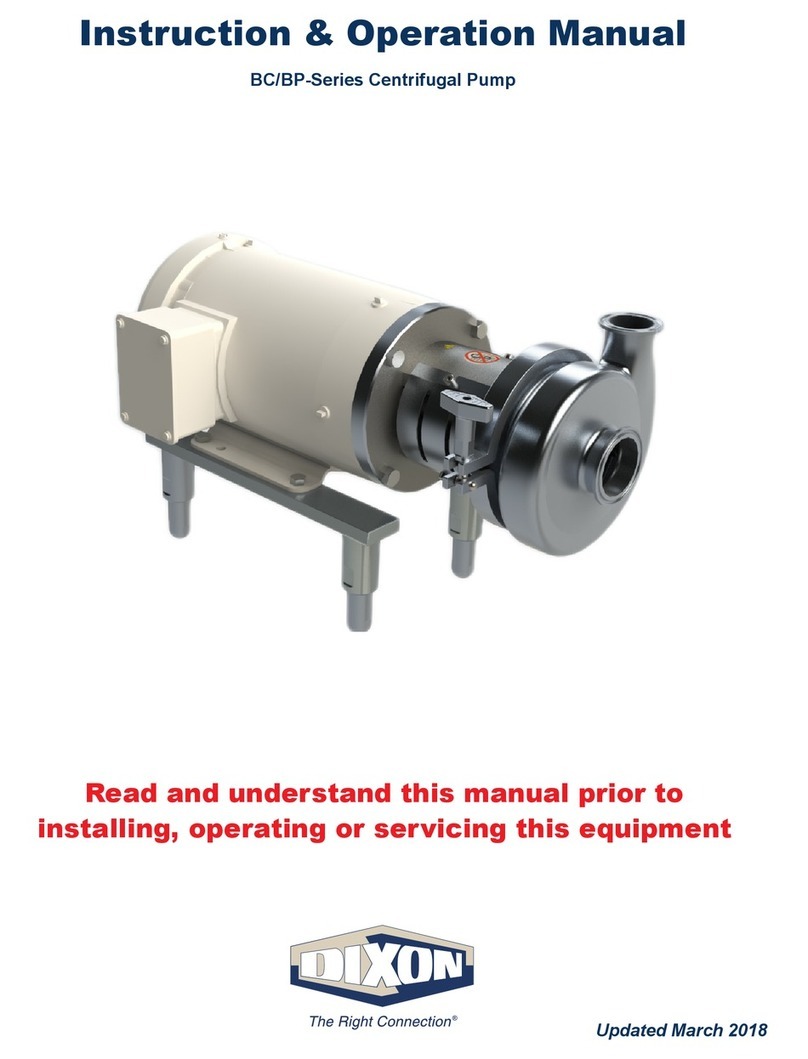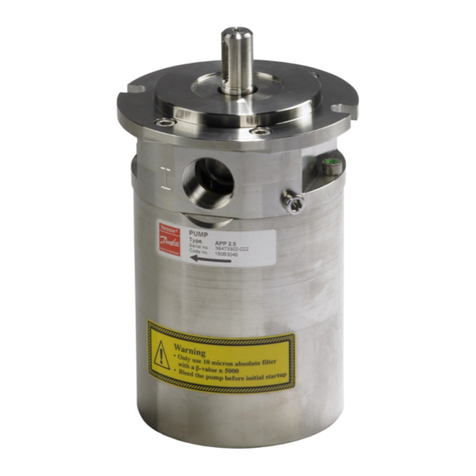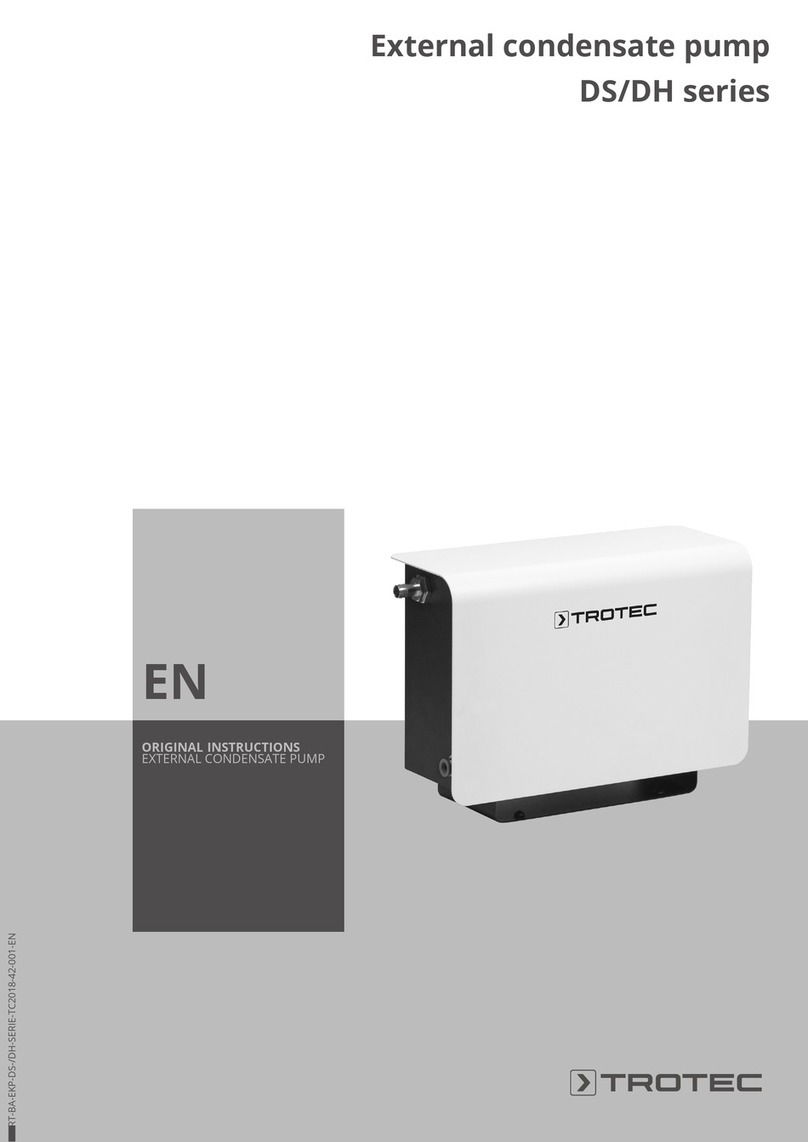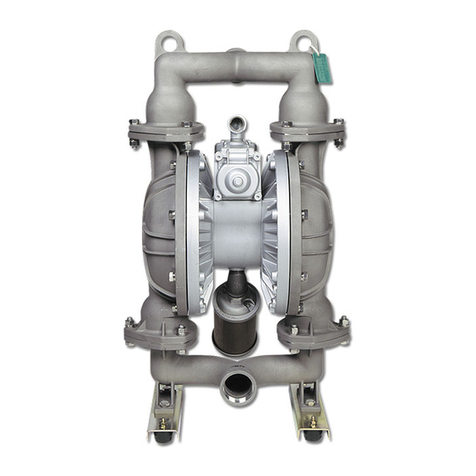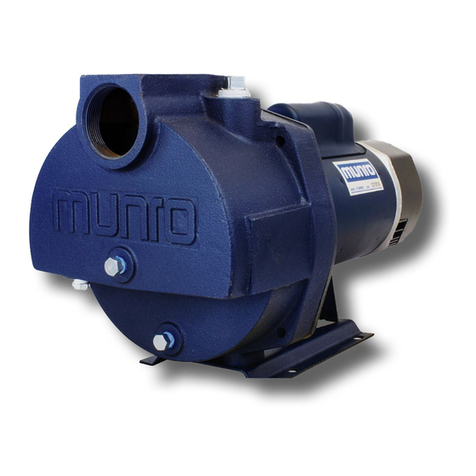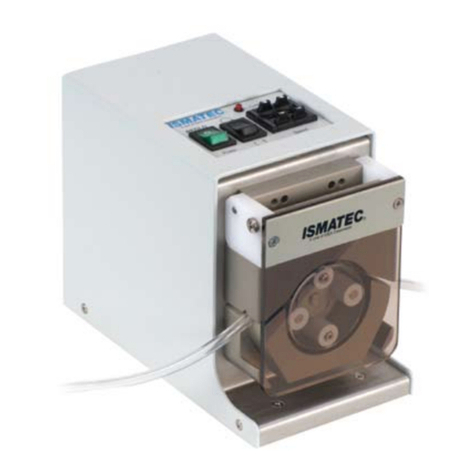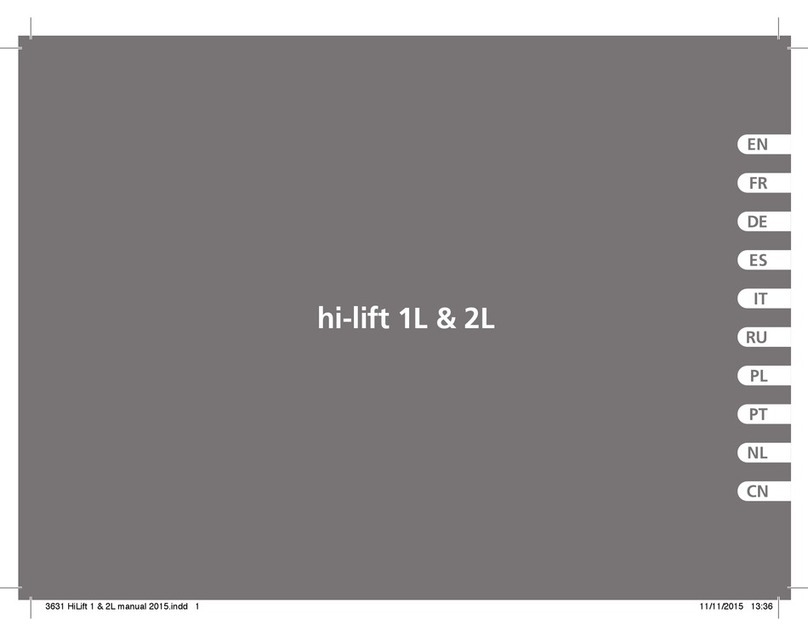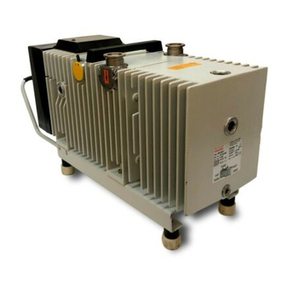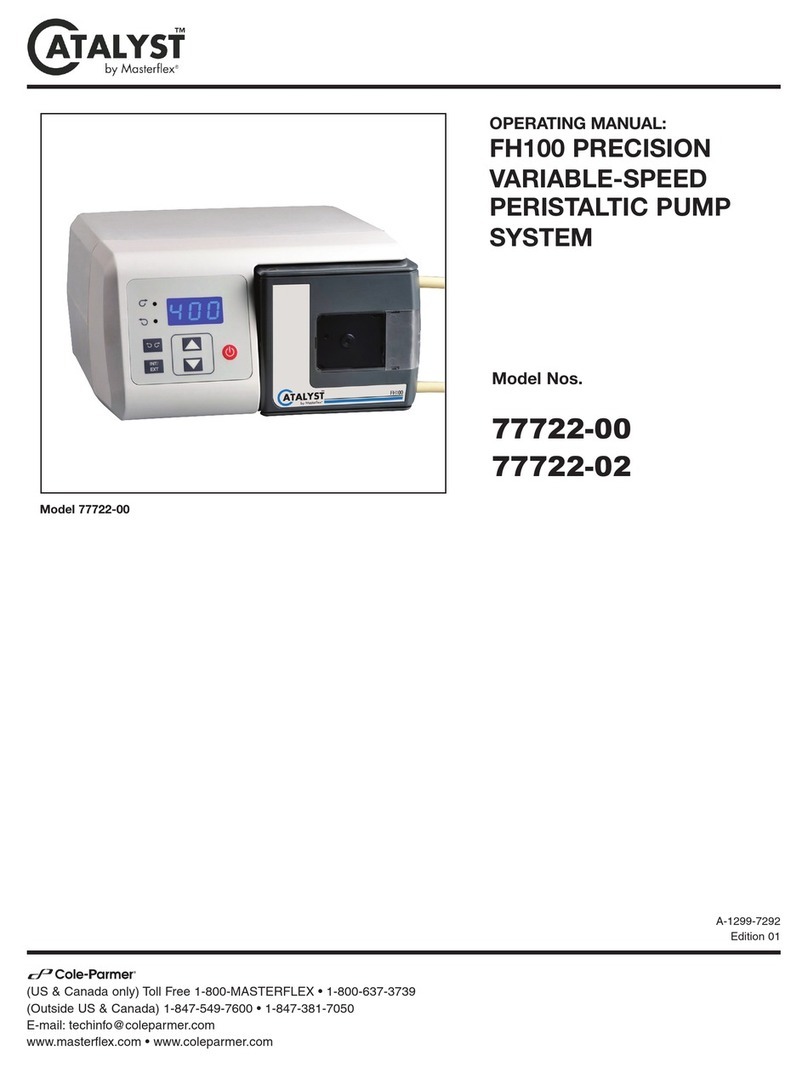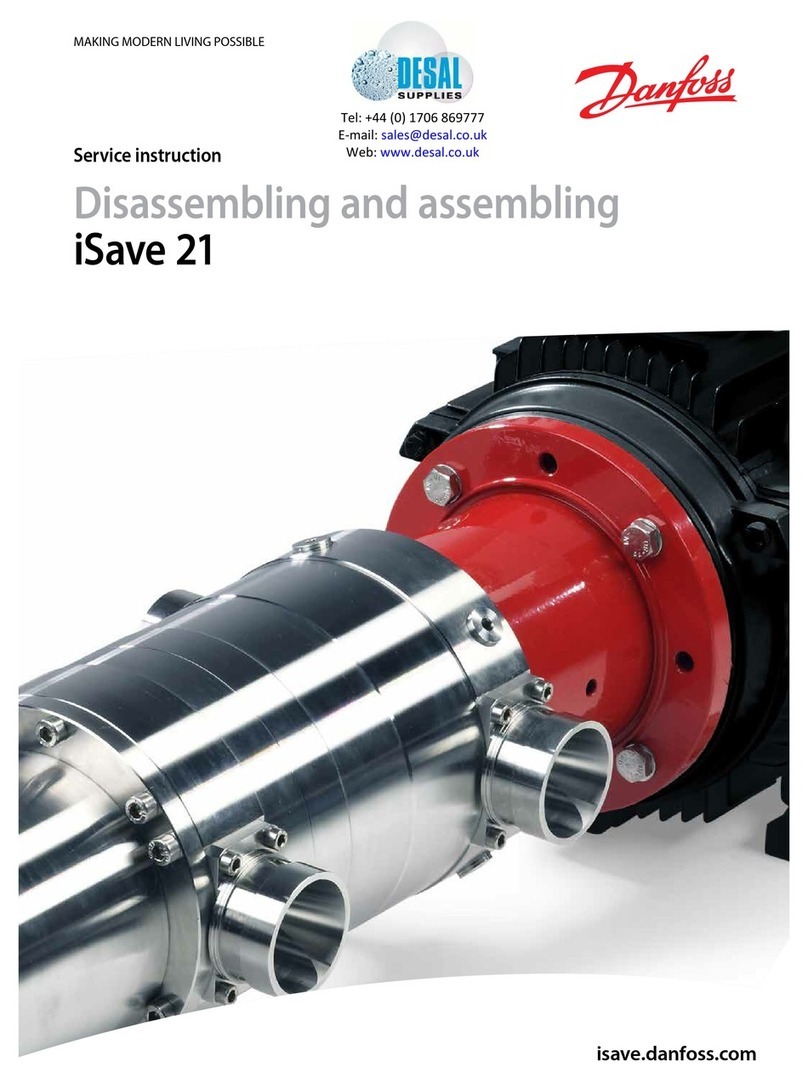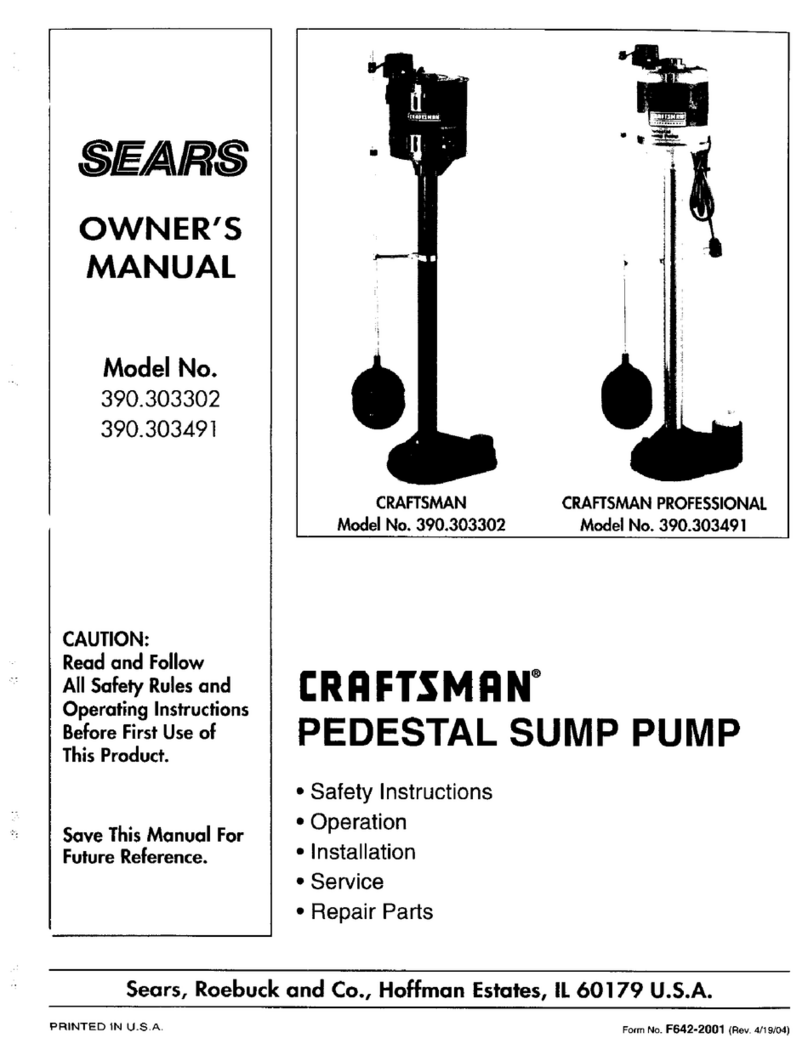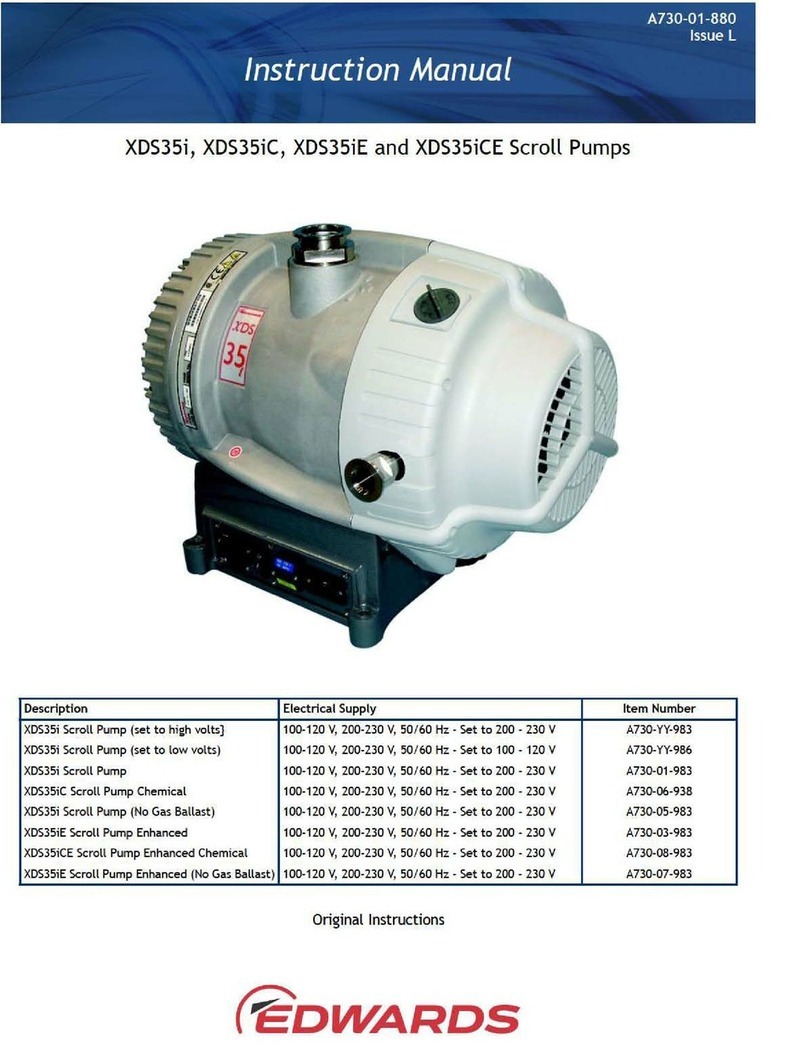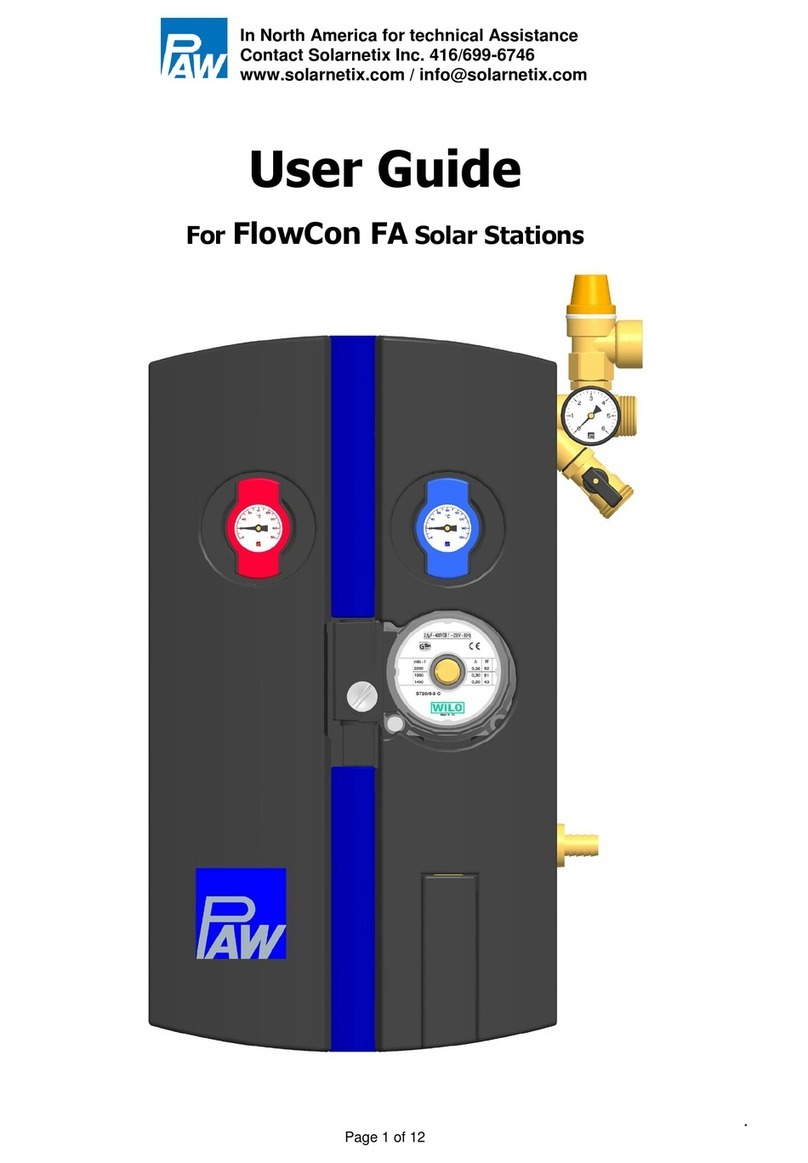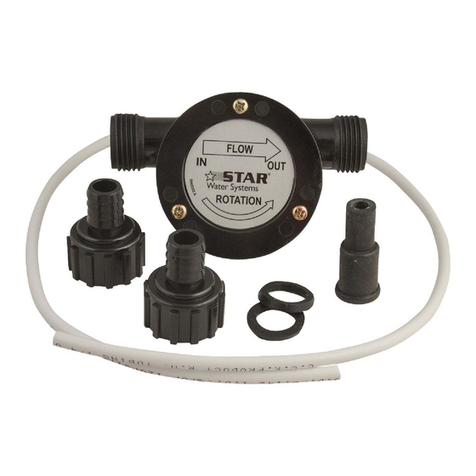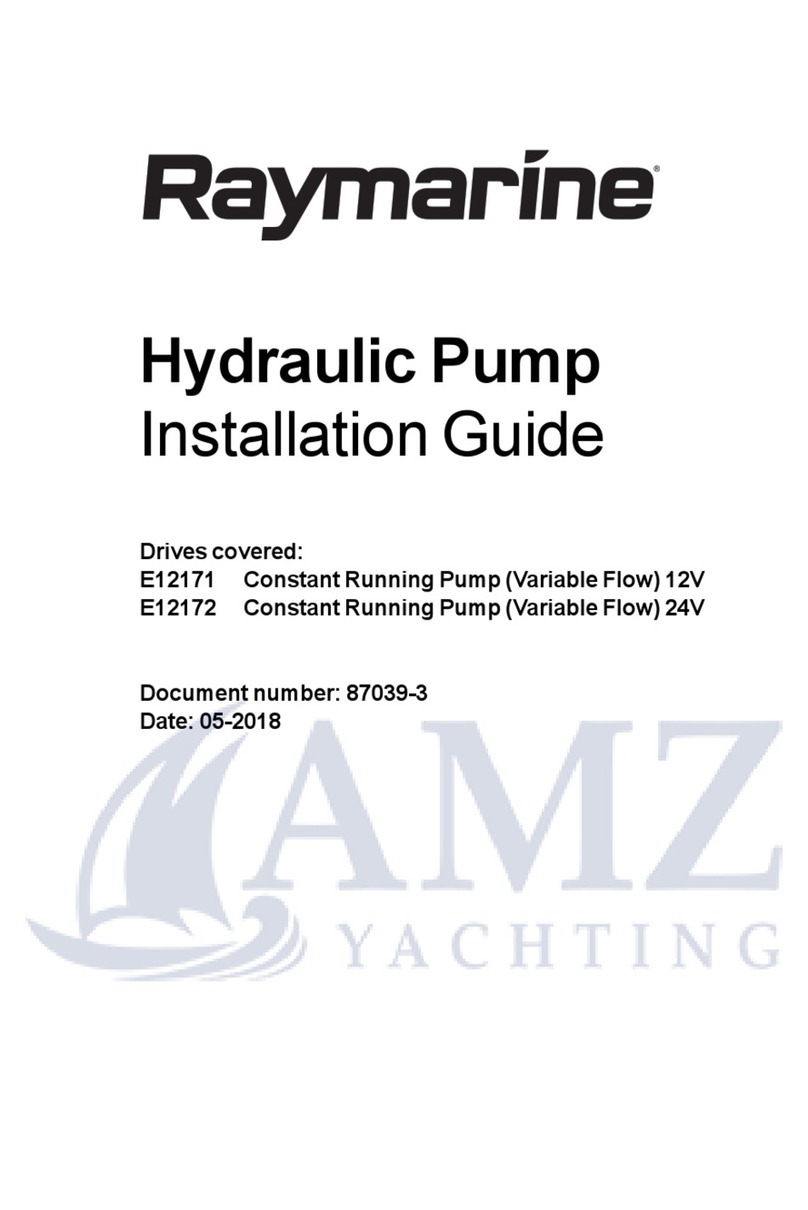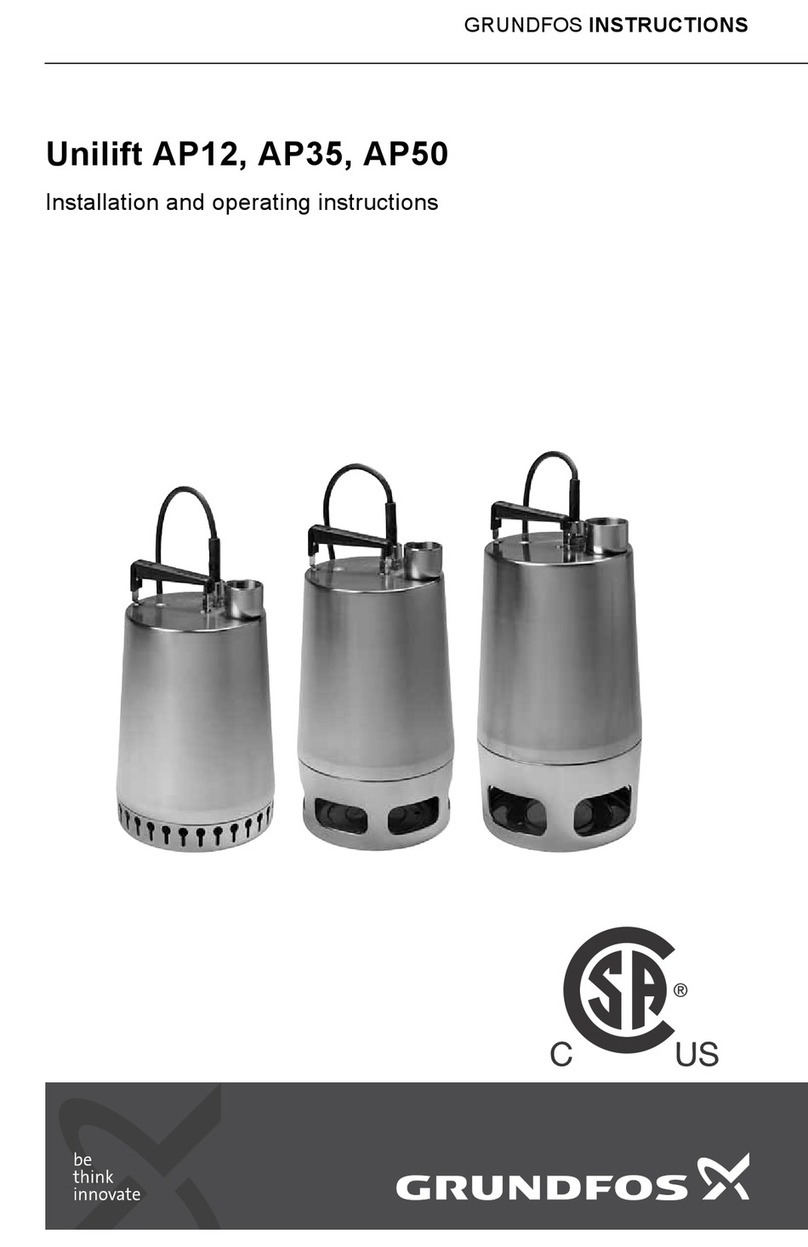Dixon MB100 Series User manual

1MB100 | IOM dixonvalve.com • 800.789.1718
MB100-Series
Centrifugal Pump
dixonvalve.com
Customer Service
800.789.1718

2MB100 | IOMdixonvalve.com • 800.789.1718
Table of Contents
Safety............................................................................................................................................................................................................3-4
Care of Stainless Steel....................................................................................................................................................................................5
Technical Specications .............................................................................................................................................................................6-7
Installation & Start Up.....................................................................................................................................................................................8
Unpacking....................................................................................................................................................................................................8
Tools Needed ..............................................................................................................................................................................................9
Welding ........................................................................................................................................................................................................9
Function Testing........................................................................................................................................................................................10
Orientation .................................................................................................................................................................................................10
General Maintenance....................................................................................................................................................................................16
Maintenance Intervals ..............................................................................................................................................................................17
Lubrication.................................................................................................................................................................................................17
Inspection ..................................................................................................................................................................................................18
Cleaning............................................................................................................................................................................................... 18-19
Assembly and Disassembly ................................................................................................................................................................... 19-20
Repair Kits .....................................................................................................................................................................................................21
Bill of Materials .............................................................................................................................................................................................22
Dimensions....................................................................................................................................................................................................23
Model Numbers & Part Numbers.................................................................................................................................................................24
Troubleshooting ............................................................................................................................................................................................25
Warranty ........................................................................................................................................................................................................26

3MB100 | IOM dixonvalve.com • 800.789.1718
Safety
General Guidelines
• The owner must comply with these operating instructions and the authorized use of this piece of equipment. Should problems
arise that cannot be solved using these operating instructions, please contact Dixon Sanitary. We will be happy to provide
further assistance.
• If any modication work is performed on the product by the owner, Dixon shall no longer be considered the manufacturer of the
device. In such cases, all components must be subjected to a new certication process for any applicable certications that the
equipment holds. Unless agreed to in writing by Dixon, liability, warranties, and guarantees shall immediately be deemed null and
void as soon as you:
- Perform modications/conversion work on the product.
- Use the product for unauthorized purposes.
- Remove or disable safety elements.
- Process products whose material, form, and size do not correspond exactly to the description provided.
- Make alterations to the original state of the device.
• The operating instructions are regarded as part of the valve.
• The operating instructions shall be valid for the entirety of the device's lifespan.
• The operating and maintenance personnel must always be able to access the operating instructions.
• The safety instructions provided in the operating instructions must be observed.
• The operating instructions must be maintained and updated as necessary.
• The operating instructions must be passed on to any subsequent owners or operators of the device.
The following signs may be used in this manual. To avoid serious injury and/or possible damage to equipment, pay attention to
these messages. Hazards or unsafe practices could result in severe personal injury or death.
Use only replacement parts and devices recommended by the manufacturer to maintain the integrity of the equipment. Make sure the
parts are properly matched to the series, model, serial number, and revision level of the equipment.
Safety labels are placed on equipment where appropriate. Do not remove any labeling from any piece of equipment. Replace any label
that is missing.
DO NOT modify any Dixon® product. Non-factory modications could create hazardous conditions and void all warranties. DO NOT
attempt to use a Dixon product in any application that exceeds the product rating.
Indicates a hazardous situation which, if not avoided, will result in death or serious injury.
Indicates a hazardous situation which, if not avoided, could result in minor or moderate injury.
May also be used to alert against an unsafe operating or maintenance practice.
Indicates a hazardous situation which, if not avoided, could result in death or serious injury.

4MB100 | IOMdixonvalve.com • 800.789.1718
Safety
Owner Must Ensure...
• The product is used only as authorized.
• The product is used only when it is in fault-free, fully functional condition and the safety equipment is regularly checked to ensure
that it is fully functional.
• The product is operated, maintained, and repaired only by personnel with the appropriate qualications and authorization.
• Checks are made before the product is put into operation to ensure that only the authorized person is in the work area and no one
is in danger of being injured if the product is in operation.
• The product is checked for visual damage prior to commissioning to ensure that it is operated only when free of faults.
• Any defects are reported immediately to the appropriate supervisor.
• All safety and warning notices attached to the equipment are legible, and none are removed.
• The operating instructions are always kept close to the product operation site, in a legible and complete state.
• Personnel are regularly instructed on all occupational safety and environmental protection issues and are familiar with and observe
the operating instructions, especially the safety instructions contained herein.
• Personnel are trained and supervised to ensure that they follow safety measures, including the obligatory use of personal
protective equipment.
• The product is only connected to pipelines that are depressurized at the time of connection.
• There is no tensile or compressive stress acting on the product connections.
• There is no residual risk at any point where pressure could occur. Pressure can cause sudden failure in or damage to the lines and
connections.
• Warning notices in the documentation for supplier modules are observed and integrated into the risk assessments
in the workplace.

5MB100 | IOM dixonvalve.com • 800.789.1718
Care of Stainless Steel
The stainless steel components in Dixon Sanitary equipment are machined, welded, and assembled by skilled craftsmen using
manufacturing methods that preserve the corrosion-resistant quality of the stainless steel. Retention of corrosion-resistant
qualities under processing conditions requires regular attention to the precautions listed below. Examples of corrosion that can
result from improper care are included below.
• Regularly check all electrical devices connected to the equipment for stray currents caused by improper grounding,
damaged insulation, or other defects. Corrosion: Pitting often occurs when stray currents encounter moist
stainless steel.
• Never leave rubber mats, ttings, wrenches, or other tools in contact with stainless steel. Corrosion: pitting or galvanic action.
Objects retard complete drying, preventing air from reforming the protective oxide lm. Galvanic corrosion occurs when two
dissimilar metals touch when wet.
• Immediately rinse equipment after use with warm water until the rinse water is clear. Clean the equipment (COP or CIP) as soon as
possible after rinsing. Corrosion: discoloration, deposits, and pitting. Product deposits often cause pitting beneath the particles.
• Use only recommended cleaning compounds. Purchase chemicals from reputable and responsible chemical manufacturers
familiar with stainless steel processing equipment. Ensure they continuously check the effects of their products on stainless steel.
• Use cleaning chemicals exactly as specied by the manufacturer. Do not use excessive concentrations, temperatures, or exposure
times. Corrosion: pitting, discoloration, or stress cracks. Permanent damage often occurs from excessive chemical concentrations,
temperatures, or exposure times.
• For manual cleaning, use only soft non-metallic brushes, sponges, or pads. Brush with the grain on polished surfaces to avoid
scratching the surface. Corrosion: pitting, scratches. Metal brushes or sponges will scratch the surface and promote corrosion
over a period of time. Metal particles allowed to remain on a stainless steel surface will cause pitting.
• Use chemical bactericides exactly as prescribed by the chemical manufacturer in concurrence with the local health authority.
Use the lowest permissible concentration, temperature, and exposure time possible. Flush immediately after bacterial treatment.
In no case should the solution be in contact with stainless steel for more than 20 minutes. Corrosion: Protective lm destroyed.
Chlorine and other halogen bactericides can destroy the protective lm. A few degrees' increase in temperature greatly increases
chemical activity and accelerates corrosion.
• Regularly inspect the joints in pipelines. Be sure all connections are tight tting without binding. Corrosion: crevice corrosion.
Small crevices caused by improperly seated gaskets will promote crevice corrosion. Stainless steel under stress will develop stress
cracking, especially in the presence of bactericides containing chlorine.
• Regularly inspect equipment for surface corrosion (i.e. pitting deposits, stress cracks, etc.). If deposit or color corrosion is
detected, remove it immediately using mild scouring powder and detergents. Rinse thoroughly and allow to air dry. Review
production and cleaning procedures to determine the cause. Note: If corrosion is not removed, the protective lm cannot be
restored, and corrosion will continue at an accelerated rate.

6MB100 | IOMdixonvalve.com • 800.789.1718
Technical Specications
Materials of Construction Technical Data
• Product contact components: AISI 316L
• Non-product contact components: AISI 304
Sealing Materials Technical Data
• Product contact components: FKM, EPDM, PTFE
Product Temperature Technical Data
• Maximum operating temperature: 212°F (100°C)
• Minimum operating temperature: 32°F (0°C)
Surface Finish Technical Data
• Product contact components: Ra ≤ 32
• Optional nishes: 15 Ra, 20 Ra, 25 Ra
• Non-product contact components: Ra ≤ 63
Connections
• Clamp (standard)
• Others available upon request
Viscosity
• 0-500 cPs
Seal Types
• Single mechanical seal
Cleaning Method
• CIP – Clean-in-Place
Performance Characteristics
• Nominal capacity: up to 75 GPM
• Nominal speed: up to 3500 RPM - 60 Hz
Motors and Mounting
• Motor frame size: NEMA 56C C-Face
• Speeds: 1750 & 3450 RPM
• Enclosure: TENV or TEFC, stainless steel or epoxy white washdown
Pump Connection Size
• Inlet: 1-1/2"
• Outlet: 1"

7MB100 | IOM dixonvalve.com • 800.789.1718
Performance Curves
Based on H2O @ 70°F
Frequency: 60 HZ
RPM: 1750 & 3500
Size: 1.5 x 1 x 3.68

8MB100 | IOMdixonvalve.com • 800.789.1718
Installation and Start Up
Unpacking
Carefully unpack all the components of the pump, unless already fully assembled when received, and inspect each part for any
damage that may have occurred during shipment. Report any damage to the carrier immediately. The ports on the pump are
protected with a plastic cover. If any covers are missing or damaged, inspect the ports on the pump thoroughly for any damage.
The pump is shipped with all necessary certicates and manuals. Please add this paperwork to the plant maintenance les for
future use and reference. Additional information for the pump can be found at dixonvalve.com
The product consists of the following components:
The following should be performed upon receiving the product and prior to installation and use of the product. It is important that
all the following processes and procedures are carefully followed and adhered to. Dixon®is not responsible for any damage that
occurs during the unpacking or installation process.
Part Type Part Number Item Number Material Description Qty
casing MB100-PC-C 1 316L MB100 casing 1
casing seal MB100-PCOR-V 2 FKM MB100 casing seal - FKM 1
impeller nut MB100-IN 3 316L MB100 impeller nut 1
impeller O-ring MB100-NOR-V 4 FKM MB100 impeller O-ring - FKM 2
impeller MB100-IMP-36680 5 CF3M MB100 impeller 3.680" diameter 1
casing clamp 13MHHM400 6 CF8 MB100 casing clamp 1
backplate MB100-BKPL 7 316L MB100 backplate 1
stationary seal
gasket - inner MB100-SSIG 8 PTFE MB100 inner stationary seal gasket 1
stationary seal MB100-SS-SC 9 sintered silicon
carbide MB100 stationary seal - sintered SiC 1
stationary seal
O-ring MB100-SSOR-V 10 FKM MB100 stationary seal O-ring 1
stationary seal
gasket - outter MB100-SSOG 11 PTFE MB100 outer stationary seal gasket 1
backplate seal ring MB100-SSP 12 304 MB100 backplate seal ring 1
seal plate screw MB100-SPS 13 18-8 MB100 seal plate screw 4
rotary seal MB100-RS-C 14 carbon MB100 rotary seal 1
rotary seal O-ring MB100-RSOR-V 15 FKM MB100 rotary seal O-ring 1
seal spring MB100-SPR 16 304 MB100 seal spring 1
stub shaft MB100-SHFT 17 316L MB100 stub shaft 56C 1
stub shaft bolt MB100-SBOLT 18 18-8 MB100 stub shaft bolt 1
adapter MB100-ADP 19 304 MB100 adapter 1
adapter bolt P71B-114B-56AB 20 18-8 adapter bolt 4

9MB100 | IOM dixonvalve.com • 800.789.1718
Tools Needed
The following tools will be required for any maintenance of the product:
Item 1: Jax®Purgel Klear food grade grease
Item 2: 5/16" box wrench
Item 3: gasket pick tool
Item 4: 3/16" allen wrench
Item 5: 13/16" socket & ratchet
Item 6: liquid thread locker
Item 7: adjustable wrench
Welding
• For equipment delivered with weld end connections, any rubber or plastic components MUST be removed from the equipment
prior to welding. (See disassembly instructions for proper removal of such components.)
• Follow all necessary safety precautions, check lists, and standard procedures prior to performing any welding on the equipment.
• Weld the equipment into the process line, being sure to follow and comply with appropriate industry welding procedures and
standards. For equipment used in food, beverage, or dairy applications that carries 3A certication, see 3A standard 00-01-2018
section E1.1.1 for proper procedure and requirements.
• Reassemble the equipment per the assembly section of this manual.
• Check the equipment for proper operation and perform leak test if necessary.

10 MB100 | IOMdixonvalve.com • 800.789.1718
Installation and Start Up
Function Testing
• Check visually to ensure that the equipment is not leaking.
• Any defective seal that could have been damaged during disassembly or assembly must be replaced.
• Check all equipment components for any signs of damage and replace damaged components.
• Ensure that all screw ttings are tight if applicable.
• Conrm all pipes and ttings connected to the equipment permitted for use are in the intended pressure range.
• Conrm all electrical installations are protected and in accordance with appropriate safety standards if applicable.
• Check that the maximum pressure indicated on the equipment or in the specications section of this manual has
been complied with.
Location
Piping: General Guidelines
Improper piping can lead to problems with pump performance resulting in increased maintenance costs.
• Pump will perform at its best when located as close as possible to the liquid supply.
• Supply piping should be short and straight to ensure the pump has an adequate supply of liquid at all times.
• The pump should be located in an area where it is easy to inspect and do preventative maintenance or repair.
• Ensure that piping is independently supported at both the suction and discharge ports of the pump (see gure 1).
• Piping must be properly aligned to prevent any strain on the pump casing.
• Try to have as few bends as possible in all piping.
Fig. 1

11MB100 | IOM dixonvalve.com • 800.789.1718
Piping: Suction Guidelines
• Make sure line sizes used are equal to or larger than suction side (supply side) port connections on the pump.
• It is optimal to have the suction side piping as straight and short as possible. Any restrictions will affect the NPSHa.
• Maintain a straight length of pipe at a maximum of 8 diameters long at the pump inlet. (see gure 2)
Fig. 2
• To prevent air leaks, ensure all joints in suction line are sealed.
• Use an eccentric reducer with straight side up to prevent air pockets from forming which will result in a decrease in
pump efciency (see gure 3).
• To prevent a high point in the suction line from forming an air pocket which results in performance loss, horizontal suction
lines must have a gradual rise to the pump.
Fig. 3

12 MB100 | IOMdixonvalve.com • 800.789.1718
Piping: Discharge Guidelines
• Discharge side should be short and direct. Use a minimal number of restrictions (see gure 4).
• Discharge port should be oriented between 0° and 90° (see gure 5).
• While increasing the discharge line size is recommended, please note:
- Using too large of a line size may lead to motor overload and cavitation.
- Using a smaller than recommened line size will increase the pump head but lower the ow.
Fig. 4
Fig. 5
• Types of reducers to use:
- If vertical discharge - concentric
- If horizontal discharge - eccentric with straight side down

13MB100 | IOM dixonvalve.com • 800.789.1718
Piping: Valve Isolation
• An isolation valve should be installed at both the suction and discharge sides of the pump. This will allow you to remove the pump
for preventative maintenance or repair without the need to drain your system.
• If the pump is not in the ooded suction condition, install a system check valve to ensure that the pump casing is ooded
for priming.
• In order to provide pump ow rate control, a VFD or control valve should be used to prevent the pump from overloading. If using a
control valve, ensure that the valve is located on the discharge side of the pump (see gure 6).
Fig. 6

14 MB100 | IOMdixonvalve.com • 800.789.1718
Mounting: Leg Kits Installation and Leveling
The pump can be easily leveled by installing a leg kit to the motor of the pump assembly. Depending on the style of leg kit, the legs
can be individually adjusted by either loosening the set screw and adjusting the leg bar or by rotating the bottom of the leg to raise or
lower the leg. PLEASE NOTE: any leg kit used must have a height of sufcient length to provide a minimum clearance of 2" (50 mm)
on pumps having a horizontal base area of 1ft2(0.095m2) or less and not designed to be xed on the oor. ANY legs made of hollow
stock should be sealed.
Example 1 Style
Example 2 Style

15MB100 | IOM dixonvalve.com • 800.789.1718
Electrical
All power must be off and locked out during the installation process.
Only registered electricians should perform the electrical installation.
• Follow motor manufacturer's installation procedures.
• Verify motor nameplate data is compatible with existing electrical supply.
• Verify pump rotation. An arrow sticker is supplied with every pump to show the correct pump rotation. If the arrow sticker is
missing, contact Dixon Sanitary for a replacement.
• Correct rotation is counterclockwise when facing pump inlet connection (see gure 7).
The pump contains moving parts. DO NOT place hands into any of the casing ports during operation. DO NOT
place hands or ngers in or around the pump shaft at any time during operation. DO NOT service the pump
unless electrical power is off and locked out according to your plant lock-out procedure.
Fig. 7
Keep
Hands
Clear

16 MB100 | IOMdixonvalve.com • 800.789.1718
Cleaning - Before Start Up
IMPORTANT: Before operating the equipment during formal production, please follow the guidelines listed below to ensure that your
equipment is clean and ready for service.
• Ensure that the equipment is installed in a proper orientation to allow the equipment to be cleaned and drained properly. Reference
the installation and start up section of the manual for orientation guidelines.
• Flush the equipment with an appropriate cleaning agent to remove any residue that may be on the equipment from shipping.
IMPORTANT: DO NOT use cleaning agents that will attack stainless steel or the elastomers that were supplied with the pump. If
you are unsure what elastomer is used in the pump, reference the part number key in this manual to make the determination.
• Follow any MSDS instructions for proper use or handling of cleaning agents.
• Flush the equipment to remove any soiling from the product contact components. Depending on the process, there may be varying
amounts of soiling. Cleaning times and cleaning agent concentrations will vary depending on the product being processed. It is the
responsibility of the operator to determine and adjust these cleaning specications as necessary.
• The equipment should not be allowed to sit with product present in it for extended periods of time. Equipment should be cleaned
immediately after processing is complete.

17MB100 | IOM dixonvalve.com • 800.789.1718
General Maintenance
To ensure proper operation of your Dixon®equipment, proper maintenance must be performed at regular intervals. To prevent
damage, check all tting connections and screw connections for any loosening of the connections during equipment operation.
Maintain adequate spare parts stock for all replacement components on the piece of equipment. Please refer to the repair kits
section of the manual for complete component part numbers and kit part numbers.
Servicing Intervals
Recommended intervals for one shift operation would be 3 months. However, only the user/owner can determine the appropriate
service intervals as the length between service intervals is dependent on the following parameters:
• Duration of use per day - hours of operation
• Type of product
• Product temperature
• Product viscosity
• Cleaning agent
• Type of cleaning (CIP/SIP/COP)
Lubrication
Please use the chart below for proper grease types for varying component materials. DO NOT use mineral or animal-product-based
greases. Check all visible seals for any signs of damage and replace as necessary. For sliding surfaces, use Jax PurGel Klear
food grade grease. If a different grease is used other than what is specied in this manual, there is a risk of damaging the seals.
Lubrication is only required when the equipment is being reassembled after servicing.
Seal Material Grease Type
EPDM Jax PurGel Klear
FKM Jax PurGel Klear
PTFE Do Not Grease

18 MB100 | IOMdixonvalve.com • 800.789.1718
General Maintenance
Inspection
Inspection of the components listed below should be done during regular servicing intervals. Before removing the equipment from
the process line, please take care to do the following:
• Clean the process line completely to remove any product that may be harmful if contacting a person.
• Drain the process line completely that connects to the equipment being serviced.
• Close any isolation valves on either side of the equipment being sevriced.
• Once the equipment has been removed from the line, cap the lines that were connected to the piece of equipment being serviced to
prevent any foreign material from entering the line.
Components to be inspected: (refer to BOM for part numbers and description)
• Items 1-4
• Items 7-15
Any components that show signs of severe wear or damage should be replaced during the scheduled maintenance time for the
equipment. Please refer to the assembly and disassembly section of this manual for proper instructions on removing and replacing
any worn or damaged components. Replacement components and repair kits can be found in the BOM or repair kits section of this
manual.
Manual Cleaning (COP)
1. Refer to the disassembly section of the manual and follow instructions to remove all product contact components.
2. Inspect the product contact components of the equipment for any signs of possible damage. Replace components as
necessary. (see the equipment BOM in this manual for replacement component part numbers.)
3. Clean all surfaces of the product contact components by manually brushing in a bath of cleaning solution (acid detergents or
simple alkaline soda type detergents).
4. After cleaning, rinse all components thoroughly with water.
5. Refer to the assembly section of the manual and follow instructions to properly reassemble the equipment.

19MB100 | IOM dixonvalve.com • 800.789.1718
Cleaning in Place (CIP)
1. Regularly ush the pump with a suitable medium to preserve seals and integrity of the product contact surfaces, such as when
there is a product changeover or downtime. These intervals shall be determined by the end user.
2. IMPORTANT: Only use cleaning agents which will not harm the seals and stainless steel.
3. Follow any MSDS instructions for proper use or handling of cleaning agents.
4. The necessary cleaning times, temperatures, and cleaning agents will depend on the degree of contamination and must be
adapted accordingly.
5. Cleaning ow velocities of 5-6 ft/s should be maintained for proper cleaning of the equipment.
6. After cleaning, rinse the equipment thoroughly with water.
Assembly and Disassembly
To ensure quality operation of your Dixon®equipment, the equipment must be disassembled and assembled properly to prevent
equipment damage during operation. Please follow the instructions contained in this manual carefully and be sure to follow any
safety warnings contained herein. If any questions should arise during the assembly or disassembly process that are not addressed
in this manual, please feel free to contact Dixon Sanitary at 800.789.1718.
Assembly
1. Place the pump shaft (item 17) onto the motor shaft and slide down until it bottoms out completely.
2. Thread the two stub shaft bolts (item 18) into the stub shaft (item 17). Tighten the shaft bolts using a 3/16" Allen wrench
to 19 ft-lbs.
3. Place adapter (item 19) on the motor and ensure that the drain hole is facing down. Thread the four hex bolts (item 20) through
the adapter holes and into the motor. Tighten down the hex bolts using an adjustable wrench.
4. Apply food grade Jax PurGel Klear grease to the rotary seal O-ring (item 14) and slide the O-ring onto the stub shaft (item 17).
5. Slide the seal spring (item 16) onto the stub shaft (item 17).
6. Place the rotary seal spring (item 14) onto the seal spring (item 16). Rotate the rotary seal until the notch in the seal aligns with
the seal driver pin on the stub shaft (item 17).
7. Press the inner stationary seal gasket (item 8) into the recessed groove of the stationary seal (item 9).
8. Press the outer stationary seal gasket (item 11) onto the outer diameter of the stationary seal (item 9).
9. Apply Jax PurGel Klear grease to the stationary seal O-ring (item 10) and press rmly into the O-ring groove in the backplate
(item 7).
10. Carefully press the stationary seal and gasket assembly into the backplate (item 7) making sure that the outer stationary seal
gasket (larger diameter) is facing up.
11. Place the backplate seal ring (item 12) on top of the stationary seal assembly and align the holes in the backplate seal ring (item
12) with the tapped holes in the backplate (item 7).
12. Thread the four seal plate screws (item 13) through the backplate seal ring (item 12) into the backplate (item 7). Tighten the seal
plate screws using a 5/16" box wrench in a star pattern.
13. Apply food grade Jax PurGel Klear grease to the impeller O-ring (item 4) and place the O-ring in the O-ring groove of the pump
stub shaft (item 17)
14. Place the backplate seal assembly over the stub shaft and press down making sure that the rotary seal (item 14) engages
properly with the driver pin in the stub shaft.
15. While holding the backplate assembly down against the seal spring force, place the impeller (item 5) onto the stub shaft
(item 17).
16. While still holding the backplate in place, place the second impeller nut O-ring (item 4) into the O-ring groove in the top of the
impeller (item 5) and thread the impeller nut (item 3) onto the stub shaft (item 17).
17. Using a 13/16" socket and adjustable wrench, hold the impeller vane with the adjustable wrench and tighten the impeller nut to
120 in-lbs.
18. Apply food grade Jax PurGel Klear grease to the casing seal O-ring and t the seal into the seal groove on the backplate.
19. Press the pump casing (item 1) rmly onto the pump assembly.
20. Place the casing clamp (item 6) between the pump casing and adapter (item 19). Tighten the clamp wing nut to 25 in-lbs.

20 MB100 | IOMdixonvalve.com • 800.789.1718
Disassembly
1. Loosen the casing clamp wing nut and remove the casing clamp (item 6).
2. Remove the casing (item 1) from the pump assembly.
3. Remove the casing seal O-ring (item 2) from the backplate.
4. Using an adjustable wrench, hold the impeller vane while using the 13/16" socket wrench to loosen and remove the impeller nut
(item 3) from the stub shaft (item 17).
5. Remove the top impeller O-ring (item 4) from the impeller (item 5).
6. Remove the impeller (item 3) from the stub shaft (item 17).
7. Remove the backplate assembly from the pump adapter.
8. Using the 5/16" box wrench, remove the four seal plate scews (item 13) from the seal ring (item 12).
9. Grab and pull on the stationary seal (item 9) to remove the seal and seal gaskets from the backplate (item 7).
10. Remove the stationary seal O-ring (item 10) from the backplate (item 7).
11. Remove the rotary seal (item 14) and the seal spring (item 16) from the stub shaft (item 17).
12. Remove the rotary seal O-ring (item 15) from the stub shaft (item 17).
13. Loosen and remove the four adapter bolts (item 20) from the adapter (item 19) using an adjustable wrench.
14. Using a 3/16" Allen wrench, loosen and remove the two stub shaft bolts (item 18) from the stub shaft (item 17).
15. Remove the stub shaft (item 17) from the motor.
Table of contents
Other Dixon Water Pump manuals
